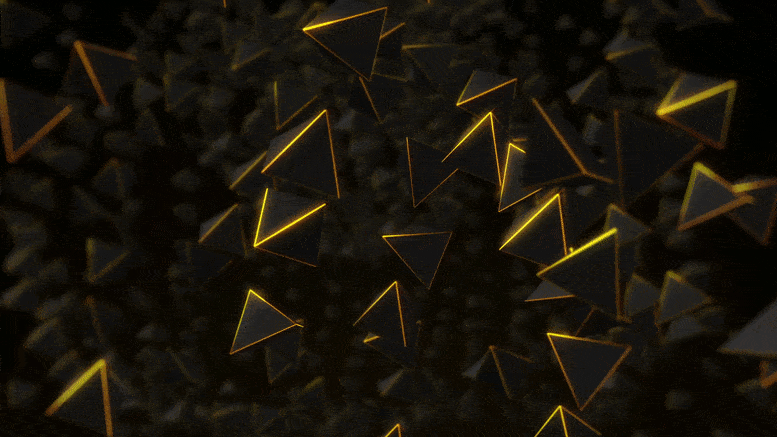
For the first time, researchers have created a Bose-Einstein condensate made from quasiparticles. (Abstract artist’s concept.)
Physicists have created the first Bose-Einstein condensate — the mysterious “fifth state” of matter — made from quasiparticles. These are entities that do not count as elementary particles, although they can still have elementary-particle properties such as charge and spin.
For decades, it was unknown whether quasiparticles could undergo Bose-Einstein condensation in the same way as real particles, and it now appears that they can. This discovery is set to have a significant impact on the development of quantum technologies including quantum computing.
A paper describing the process of creation of the substance, which was achieved at temperatures just a tiny bit above absolute zero, was published recently in the journal Nature Communications.
Bose-Einstein condensates are sometimes described as the fifth state of matter, alongside solids, liquids, gases, and plasmas. Theoretically predicted in the early 20th century, Bose-Einstein condensates, or BECs, were only created in a lab as recently as 1995. They are also perhaps the strangest state of matter, with a great deal about them remaining unknown to science.
A close-up picture of the apparatus in a cryogen-free dilution refrigerator. A dark red-colored cubic crystal in the center of the picture is cuprous oxide. A zinc selenide meniscus lens placed behind the crystal is an objective lens. A rod and a stage below the crystal are used for generation of an inhomogeneous strain field in the crystal that acts as a trap potential for excitons. Credit: Yusuke Morita, Kosuke Yoshioka and Makoto Kuwata-Gonokami, The University of Tokyo
BECs occur when a group of atoms is cooled to within billionths of a degree above absolute zero. Researchers commonly use lasers and “magnet traps” to steadily reduce the temperature of a gas, typically composed of rubidium atoms. At this ultracool temperature, the atoms barely move and begin to exhibit very strange behavior. They experience the same quantum state — almost like coherent photons in a laser — and start to clump together, occupying the same volume as one indistinguishable “super atom.” The collection of atoms essentially behaves as a single particle.
Currently, BECs remain the subject of much basic research, and for simulating condensed matter systems, but in principle, they have applications in quantum information processing. Quantum computing, still in early stages of development, makes use of a number of different systems. But they all depend upon quantum bits, or qubits, that are in the same quantum state.
Most BECs are fabricated from dilute gases of ordinary atoms. But until now, a BEC made out of exotic atoms has never been achieved.
Exotic atoms are atoms in which one subatomic particle, such as an electron or a proton, is replaced by another subatomic particle that has the same charge. Positronium, for example, is an exotic atom made of an electron and its positively charged anti-particle, a positron.
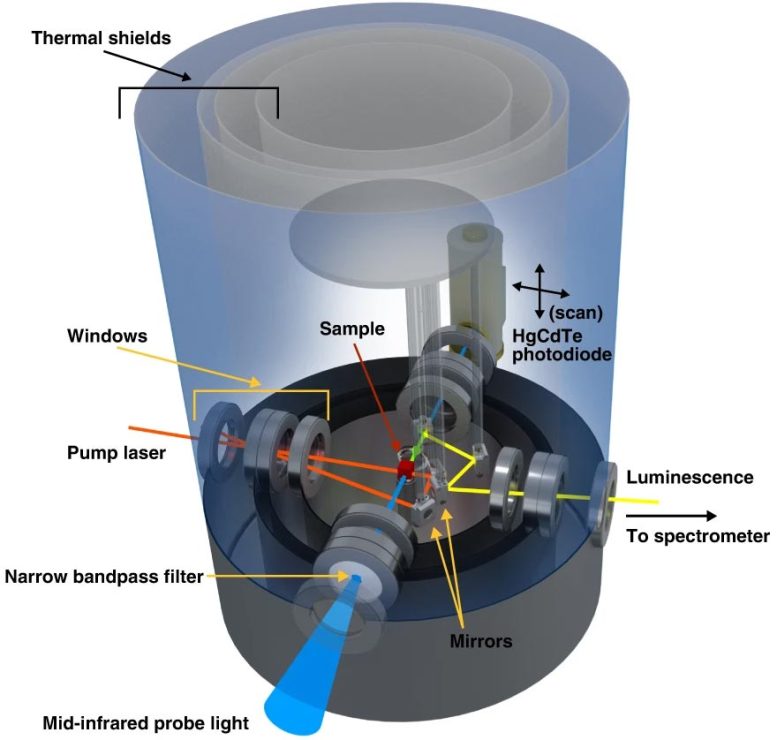
The cuprous oxide crystal (red cube) was placed on a sample stage at the center of the dilution refrigerator. Researchers attached windows to the shields of the refrigerator that allowed optical access to the sample stage in four directions. The windows in two directions allowed transmission of the excitation light (orange solid line) and luminescence from paraexcitons (yellow solid line) in the visible region. The windows in the other two directions allowed transmission of the probe light (blue solid line) for induced absorption imaging. To reduce incoming heat, researchers carefully designed the windows by minimizing the numerical aperture and using a specific window material. This specialized design for the windows and the high cooling power of the cryogen-free dilution refrigerator facilitated the realization of a 64 millikelvin minimum base temperature. Credit: Yusuke Morita, Kosuke Yoshioka and Makoto Kuwata-Gonokami, The University of Tokyo
An “exciton” is another such example. When light hits a semiconductor, the energy is sufficient to “excite” electrons to jump up from the valence level of an atom to its conduction level. These excited electrons then flow freely in an electric current — in essence transforming light energy into electrical energy. When the negatively charged electron performs this jump, the space left behind, or “hole,” can be treated as if it were a positively charged particle. The negative electron and positive hole are attracted and thus bound together.
Combined, this electron-hole pair is an electrically neutral “quasiparticle” called an exciton. A quasiparticle is a particle-like entity that does not count as one of the 17 elementary particles of the standard model of particle physics, but that can still have elementary-particle properties like charge and spin. The exciton quasiparticle can also be described as an exotic atom because it is in effect a hydrogen atom that has had its single positive proton replaced by a single positive hole.
Excitons come in two flavors: orthoexcitons, in which the spin of the electron is parallel to the spin of its hole, and paraexcitons, in which the electron spin is anti-parallel (parallel but in the opposite direction) to that of its hole.
Electron-hole systems have been used to create other phases of matter such as electron-hole plasma and even exciton liquid droplets. The researchers wanted to see if they could make a BEC out of excitons.
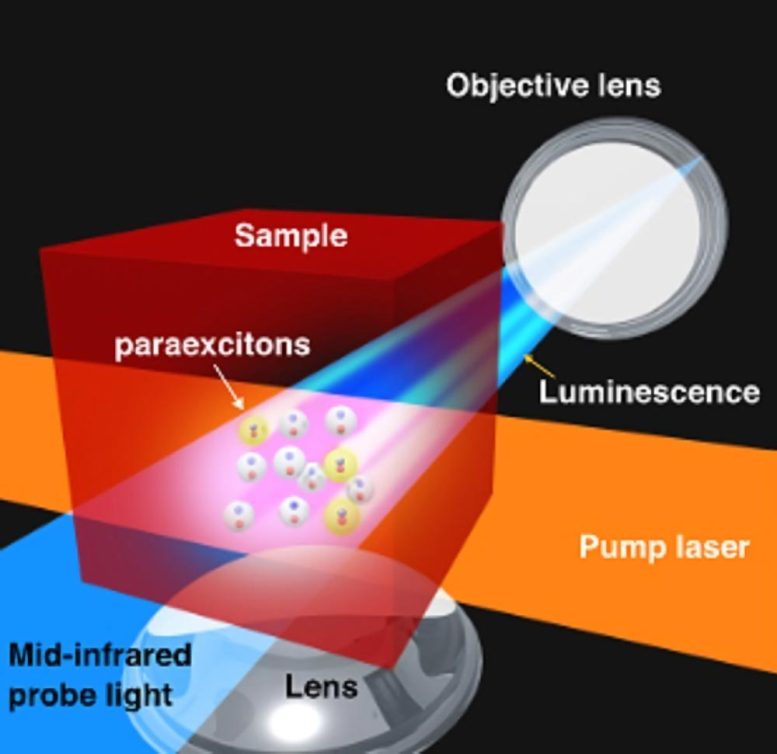
Researchers applied inhomogeneous stress using a lens set under the sample (red cube). The inhomogeneous stress results in an inhomogeneous strain field that acts as a trap potential for excitons. The excitation beam (orange solid line) was focused on the bottom of the trap potential in the sample. An exciton (yellow sphere) consists of one electron (blue sphere) and one hole (red sphere). The team detected excitons by either luminescence (yellow shade) or the differential transmission of the probe light (blue shade). An objective lens set behind the sample collected luminescence from excitons. The probe beam also propagated through the objective lens. Credit: Yusuke Morita, Kosuke Yoshioka and Makoto Kuwata-Gonokami, The University of Tokyo
“Direct observation of an exciton condensate in a three-dimensional semiconductor has been highly sought after since it was first theoretically proposed in 1962. Nobody knew whether quasiparticles could undergo Bose-Einstein condensation in the same way as real particles,” said Makoto Kuwata-Gonokami, a physicist at the University of Tokyo and co-author of the paper. “It’s kind of the holy grail of low-temperature physics.”
The researchers thought that hydrogen-like paraexcitons created in cuprous oxide (Cu2O), a compound of copper and oxygen, were one of the most promising candidates for fabricating exciton BECs in a bulk semiconductor because of their long lifetime. Attempts at creating paraexciton BEC at liquid helium temperatures of around 2 K had been made in the 1990s, but failed because, in order to create a BEC out of excitons, temperatures far lower than that are needed. Orthoexcitons cannot reach such a low temperature as they are too short-lived. Paraexcitons, however, are experimentally well known to have an extremely long lifetime of over several hundred nanoseconds, sufficiently long to cool them down to the desired temperature of a BEC.
The team managed to trap paraexcitons in the bulk of Cu2O below 400 millikelvins using a dilution refrigerator. This is a cryogenic device that cools by mixing two isotopes of helium together and is commonly used by scientists attempting to realize quantum computers. They then directly visualized the exciton BEC in real space by the use of mid-infrared induced absorption imaging, a type of microscopy making use of light in the middle of the infrared range. This allowed the team to take precision measurements, including the density and temperature of the excitons, that in turn enabled them to mark out the differences and similarities between exciton BEC and regular atomic BEC.
The group’s next step will be to investigate the dynamics of how the exciton BEC forms in the bulk semiconductor, and to investigate collective excitations of exciton BECs. Their ultimate goal is to build a platform based on a system of exciton BECs, for further elucidation of its quantum properties, and to develop a better understanding of the quantum mechanics of qubits that are strongly coupled to their environment.
Reference: “Observation of Bose-Einstein condensates of excitons in a bulk semiconductor” by Yusuke Morita, Kosuke Yoshioka and Makoto Kuwata-Gonokami, 14 September 2022, Nature Communications.
DOI: 10.1038/s41467-022-33103-4


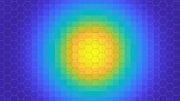
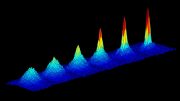

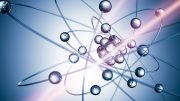
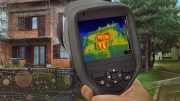

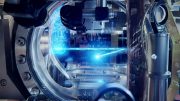
Applying these findings to my personal model of the universe: “a spectrum of various forms, levels and/or states of energy from mindless matter to matterless mind” and “matter may be defined as various forms of encapsulated heat,” together, all three tend to reinforce my conclusion that at absolute zero matter would convert into pure sentience, the highest form/frequency/level/state of energy. And, it is also consistent with my tenth law of energy: “Anything to the extreme is it’s own opposite.” At the opposite end of the Bose-Einstein ‘slush-to-sentience’ conversion, in the absence of heat, is life; the room temperature conversion of lower forms of energy into various frequencies/grades/tones of pure sentience. I find that where the differences lie are in the true nature of gravity: pulsating coiling and spiraling coherent lines of attractive force radiating outward in decreasing density and strength to the ends of the universe, with locally dense ambient gravity causing photons, electrons and small molecules to appear as both particles of encapsulated heat and radiant waves in the classic double-slit experiments. I believe to prove me wrong it will be necessary to launch a fully self-contained double-slit experiment into deep space where there are too few lines of pulsing gravity force to create the easily misinterpreted diffusion pattern of waves.
The first BEC of quasiparticles–has been not understood for decades. That’s because we don’t know the true nature of gravity. Gravitation is the beginning of all things, and is the most raw power for maintaining and connecting the world. The topological vortex field may be the graviton that physics has been looking for. Topologically trivial (N=0) graviton pairs undergo Kelvin motion, while nontrivial (N=±1) graviton pairs behave a rotational motion around a fixed guiding center. The point defects in the bifurcation processes of the graviton pairs generate or annihilate at the limit points, and encounter, split or merge at the bifurcation points of the 3-dimensional vector order parameter, and form unstable point defects system.
Thanks for the instructional reply but in my lay model of the universe there are no ‘gravitons,’ just infinitely reliable lines of attractive force induced by some higher force to pulse and radiate outward from all matter in increasingly less dense and less attractive spherical fields, to the extremes of the universe. I’ve uploaded three low-budget videos of at-home proof-of-gravity experiments to my newer Odysee dot com/@charlesgshaver video channel for anyone with an open mind who can set aside old merely descriptive labels of long recognized but unexplained phenomena. It might help to think of my ‘wheels-with-blades-of-gravity-lines-of-force’ in a ‘sea of local gravity’ as boat motor propellers in a sea of water. If/when I resume my ‘proof-of-gravity-lines-of-force’ experiments, I might even use motorized propellers in water to demonstrate the similarities. I accept that Einstein was a genius to recognize the energy to matter conversion ratio but I believe he erred when it came to gravity.
What’s up with your editing. Do journalists and writers not have to worry about punctuation, spelling grammar and sentence structure. I found tons of mistakes. I guess anybody can be a writer these days. If I were writing something going to be publish and that shows up in Google searches I’d make sure it was perfect. I’ve even seen writers make up words and use words in the wrong way. It’s sad. I guess editing is done by a cheap program.
Please edit your comments. A question mark should follow a question. (…your editing?…sentence structure?).
Methinks the pot is calling the kettle black.
FYI – First confirmed BEC was by Dr. Wolfgang Ketterle’s team at MIT. The work referenced here builds upon that.
Meanwhile, somewhere in America, people are earnestly debating how Bill Gates gets those tiny tracking chips to go through COVID vaccine needles. On their GPS enabled smartphones. We are in a mad race between technology that meets Arthur Clarke’s definition of magic and a tsunami of tstupid.
This guy is going to open a blackhole
This is terrible reporting. A simple Google search could have told the authors that the main claim–the first BEC of quasiparticles–has been incorrect for decades. (Check out condensation of phonons or of rotons, or heck just go to the Wikipedia page called “Bose Einstein condensation of quasiparticles”.)
An electron hole as a particle, creating a new type of matter?
Wow, could this be switched on and off rapidly for computing to create a new layer of logical complexity, or would it be an identical basic structure of the “ones and zeros” of quantum computing that was easier to control?
Are they trying to make quantum computing easier or more powerful?